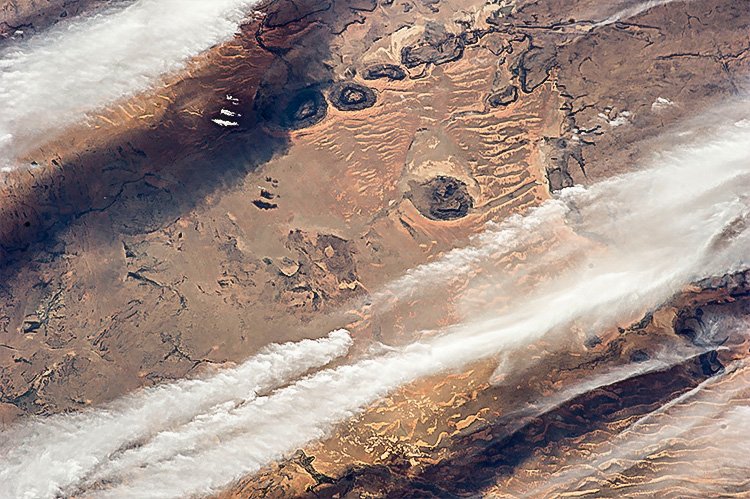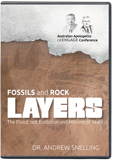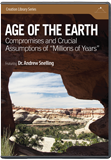
Five Mass Extinctions or One Cataclysmic Event?
Many scientists claim the fossil record shows many mass extinctions separated by millions of years. Does the Bible give a better explanation?
Imagine relaxing at your dream vacation spot. Do you prefer a tropical forest, lush and humid, where fragrances from exotic flowers overwhelm your senses? Or a sandy coast, where the sun warms your skin and the palm trees sway? Or a secluded old-growth forest, where the only sound for miles around is a trickling brook?
Now add a triceratops splashing in the water, while a duck-billed dinosaur lazily chomps on a tasty conifer tree nearby. Overhead, a pterosaur glides toward its lair in the jagged cliffs.
What an amazing world we live in, and what an amazing world it once was! Fossils indicate that the earth has been covered with a wondrous array of environments in the past.
Then something happened. The earth’s rocks indicate that past catastrophes struck on a scale unlike anything we see today. The earth’s crust split open, belching toxic fumes into the sky and sending rivers of lava that swallowed up forests and everything else in their path.
The original continent also broke apart. The land rose and fell as the broken landmasses slid around and bashed into each other. A deluge of floodwaters battered the shallow seas and coasts, and then moved inland. Terrified animals roared and screamed, seeking safety but finding none.
Meanwhile, meteorites slammed into the earth, incinerating everything in their local area, leaving death and craters in their wake.
What caused these catastrophes? When did they occur, and how did life on earth survive?
If you visit any secular natural history museum or read any secular geology textbook, you’ll find claims about five major extinction events that supposedly occurred during the earth’s many-millions-of-years history. After each extinction, new life-forms supposedly arose to replace those that died.
The Bible gives a much different picture. God made the earth and every kind of creature in a single week just 6,000 years ago. Later, because the earth was filled with evil, the Lord destroyed it in a worldwide Flood, and all the land creatures died. We can see reminders of this mass destruction everywhere. Yet God in His mercy preserved representatives of every kind of air-breathing land creature on Noah’s Ark.
Yes, the earth has endured mass extinction, but only one.
What Do We Find in the Rock Record?
Before we look at the evidence for one mass extinction versus five, let’s consider which parts of the geologic column diagram we can all agree on.
The charts in secular textbooks and museums show multiple layers with names like Cambrian, Permian, Jurassic, and Cretaceous. They also have time periods associated with those layers, and notes often tell about the five great extinctions that separate these time periods. Which parts of those charts are accurate?
First, the layers really do exist. A visit to the Grand Canyon or other US national parks, or a long drive on the highways across America, shows us distinct rock strata in cliffs and road cuts, like pancakes stacked on a breakfast plate. These rock layers are easily distinguished by their appearance and composition. Many can be traced with outcrops and drill holes right across North America and beyond, to other continents.1

photo by NASA
Lifeless areas in the Sahara remind us of destruction that once changed the face of the whole planet.
The layers from different regions around the world have been added to a “master” sequence to make a composite record of strata. That is all a geologic column diagram is—a pictorial summary of the layers we can actually see deposited around the globe.
The layers are factual, and the names are useful to identify the present-day strata. The problem arises with the dates, which estimate when the layers were deposited. They are based on speculations and multiple assumptions. The experts who assign these dates reject the Bible’s revealed historical timeline and deny that the Flood could have deposited the layers. They assume, instead, that we should interpret past (unobserved) events based on present-day (observed) processes.
This assumption is deeply flawed. The Bible reveals that God has uniquely intervened in history at key moments, which look unlike anything we see today, especially creation and the worldwide Flood of Noah’s day.
The Jurassic Period was not a past world of animals and plants that existed 150 million years ago.
Thus, for example, the so-called Jurassic Period was not a past world of animals and plants that existed 150 million years ago. It never was observed. Instead, the Jurassic layers (which we do observe today) contain a unique combination of fossils swept up by the Flood and deposited in unique layers.
The charts do provide accurate summaries of the fossil sequence. There is a definite order, from bacteria and sea creatures at the bottom to modern humans at the top.2 But it is not a clear-cut order showing evolution from one kind of creature into a very different creature, as secular scientists claim. Instead, some creatures represented in the fossil record have survived until today, unchanged. Many other fossils, now extinct, are found in multiple layers. And some creatures appear in only one layer, without any clear relationship to fossils before or after them.
These findings don’t make sense in the evolutionary scenario. But they do make sense if God created all these unique creatures separately and they were living together at the same time. From a biblical perspective, the order probably reflects the order in which different environments were buried during the Flood.
The first deposited layers of the Flood, at the base of the “Paleozoic,” are filled exclusively with shells of creatures that lived on the shallow seafloor. Since the Flood began with the breaking up of “the fountains of the great deep” on the ocean floor, the resultant earthquakes caused a series of colossal seafloor-hugging water surges to first wash away and bury sea creatures. As the Floodwaters rose higher to sweep onto the land, land-dwelling creatures got buried in successive layers. Thus the land-dwelling creatures appear higher in the fossil record.
Five Mass Extinctions?
If a single Flood buried all these creatures, why is there evidence of five mass extinctions? Consider what “mass extinctions” describes. Animals weren’t all buried together in a jumbled mess. Instead, some creatures were buried before other creatures. Whenever many different types of organisms from the same place were completely buried on a massive scale at the same levels, often no more appear higher in the fossil record. So secular scientists think they look like “mass extinctions.”
If you look closely at those charts where these five mass extinctions occur, however, you’ll notice a pattern that makes more sense as a burial from sea to land at the same time in history.
The first two (Ordovician–Silurian and upper Devonian) are just different regions of the ocean that got buried. Scientists have difficulty identifying any one cause for these deaths. They point to things like climate change, based on the chemistry of the mud and sand buried with the animals, but there is no general agreement on the cause (because there isn’t a single cause, other than the Flood itself).
The third and largest “extinction” (Permian–Triassic) is right where we would expect the biggest transition in the types of creatures buried: when the destructive waters rose from the ocean floor to begin engulfing the land!
What appears to be a big extinction is just a transition in the height of the Floodwaters, which buried different flora and fauna below and above this level. No wonder we don’t find certain sea creatures after this point—because their environments were completely buried before any land creatures were swept up by the rising water.
The next extinction (Triassic–Jurassic) does not have a distinct cause, either. It simply represents different parts of the land buried at different times during the Flood. Secular scientists still aren’t quite sure what catastrophe caused this burial.
The really big extinction that everyone knows about is the fifth and final one, the Cretaceous–Paleogene (formerly called the Cretaceous–Tertiary) extinction. This marks the burial of the last known dinosaur remains, and it is often blamed on a huge meteorite impact. But from a creationist perspective, we would expect major differences between creatures buried in the last stages of the Flood, and animals buried after Noah’s Ark landed and creatures repopulated the earth.
Notice the main difference between the biblical and secular interpretation. In the evolutionary story, the fossil record represents different environments full of creatures that lived and died at different times over millions of years. So, for example, they say seafloor creatures called trilobites were buried in lower “Paleozoic” layers over almost 300 million years. They say these creatures went extinct before the first Triassic creatures (including early dinosaurs) arose on land.
According to the Flood perspective, in contrast, the fossil record represents different environments full of creatures that lived at the same time but were buried in the order of the Flood’s destruction. The Flood buried the last of the trilobites before it reached the dinosaurs on land. The trilobites’ pre-Flood habitats were destroyed and disappeared under rapidly accumulating Flood sediments before dinosaurs and other land animals got buried.
Do we have any hard evidence that the Flood caused all this destruction over a short time? Yes, we do!
Megasequences of Rock Layers
A landmark paper in 1963 revealed that North America’s sedimentary layers, thousands of feet thick, were deposited in five large “packages” of layers called megasequences.3 At the boundaries between these packages are erosion surfaces called unconformities. These are surfaces that were sheared flat by high-energy, rapidly flowing ocean waters that rose to flood the continent and scraped away some earlier deposits.
As these surges of ocean waters slowed, they deposited sediment on top of those flattened surfaces. In general, the coarser-grained sediment particles settled first with progressively finer particles deposited on top of them. Each “package” of these graduating sediment layers is called a megasequence.
Clearly, powerful ocean floodwaters were at work to lay down these megasequences. But why are there five?
The Floodwaters reached a zenith during each of these depositional cycles, likely getting higher and higher until the whole earth was flooded as described in Genesis. Between each megasequence cycle, the waters began to retreat. As they again moved rapidly, in some places they eroded some of the sediments they had just deposited and moved them elsewhere. Between each rise and fall cycle, large portions of the continent were above water again. Any animals struggling to swim could have left footprints on the exposed wet surfaces that then hardened. The next brief wave of sediment-laden water would cover and fossilize those footprints.
In fact, the fossil record often has tracks of animals in lower layers than the fossilized remains of those animals.4 This is an enigma to secularists. How could animals make tracks and thousands or even millions of years later their bodies were buried? It makes more sense that the tracks and then the bodies were buried in the Flood over mere hours or days.
This megascale cycle of depositing “packages” was repeated, as renewed surges of ocean waters rapidly rose to again cover the continent. The cycle appears to have happened five times before most of the Floodwaters finally receded and the North American continent started to dry.
This repeated cycle appears not only across North America but also across other continents. Not just layers but megasequences.5 And the same “mass extinctions” are repeated, too, all across the globe, deposited by unimaginably powerful ocean currents.

Mass Extinction or High Water Level?
Five “mass extinctions” (red arrows) occurred in the fossil record when the earth’s oceans were near their highest point (solid blue line). The dashed line shows the sea level today.
How Did These Mass Extinctions Happen?
Refer to the diagram. Note that the “mass extinctions” coincide with the laying down of the five main (named) megasequences in the geologic record of North America. Each megasequence begins with a rise in sea level.
The extinctions occurred when the sea level was rising to its zenith and the ocean waters had flooded the continent.
This rise in sea level occurs when the ocean waters rose to flood the continent and bury marine creatures across the continent. In nearly every instance, the extinctions occurred when the sea level was rising to its zenith and the ocean waters had flooded the continent. That’s why so many “extinctions” coincide with the middle or the top of the megasequences, coinciding with a possible zenith in water height. So it makes sense that these surges destroyed and buried whole habitats.
This doesn’t help explain the evolutionary story, however. If the rising sea levels occurred at the evolutionary snail’s pace, with the water level rising slowly over thousands and even millions of years, animals could escape and reestablish their habitats on safer ground. This is even true of marine animals. But when the water level rises rapidly, as in the global Flood, animals cannot escape and are buried en masse, as we find in the fossil record.
So that explains how rising ocean water produced five layers of “mass extinction.” But what about the other main causes that evolutionists give to explain these mass extinctions (in addition to rising sea levels): (1) massive lava flows through cracks in the earth (called flood basalt eruptions) and (2) meteorite impacts?
Flood basalts were humongous eruptions of ginormous quantities of basalt lavas (lavas from hot melted upper mantle material that forms rocks when it cools). These eruptions spewed huge quantities of volcanic dust, aerosols, sulfur, and carbon dioxide into the atmosphere, causing a catastrophic change to living conditions for animals and plants. All five of these major mass extinction levels, particularly the upper three, correspond to some degree to such flood basalt super-eruptions. We see one of them in India, where lava flows accumulated in a mile-thick stack that covers an area the size of France!

image by NASA EARTH OBSERVATORY IMAGE BY JOSHUA STEVENS, USING MODIS DATA FROM LANCE
A satellite image captures three volcanos erupting in the southern Atlantic along the fault line between tectonic plates. The Flood destroyed life on earth when the earth’s crust broke up into plates.
We also find evidence of meteorite impacts. The Cretaceous-Paleogene (uppermost) mass extinction level may correlate with a massive meteorite impact, the so-called Chicxulub impact, when a large meteorite slammed into the Yucatan peninsula of Mexico. The explosion is claimed to have hurled copious amounts of dust into the atmosphere, produced mega-tsunamis, and even caused global forest fires.
Based on the biblical account, we believe disasters occurred in rapid, overlapping succession.
In reality, the existence of flood basalt super-eruptions and multiple meteorite impacts matches the global Flood cataclysm well. Based on the biblical account, we believe they all occurred in rapid, overlapping succession in just one year! They were all part of God’s earth-shattering judgment on the evil that filled the world.
God’s Providential Care
That explains how five extinctions took place during one global Flood event, with massive meteorite impacts and lava flows. But another question remains. If the upheaval and destruction were so cataclysmic, how did Noah and his Ark cargo survive?
We find the answer in Genesis 8:1:
“And God remembered Noah.
”
That’s right, Noah and the Ark survived because of God’s providential care. Did that require special miracles? No, the Ark was designed purposefully.
Neither does God’s providential care
for us today require miracles to keep
the earth hanging in space, spinning
at just the right speed at just the right
distance from the sun. We may not face
upheavals as cataclysmic as the Flood,
but all of our concerns come down to
the reassurance Jesus gave us 2000
years ago when He said, “If God so
clothes the grass . . . will He not much
more clothe you?
” (Matthew 6:30).
Like Noah, we do not have to fear hard circumstances that lie ahead because our Creator God has promised to care for His own.
Answers Magazine
March–April 2017
How do we see our Creator in the kitchen? The infinite diversity of delicious food shows His lavish love.
Browse Issue SubscribeFootnotes
- Andrew A. Snelling, “Sifting Through Layers of Meaning.” Answers 10.4 (2015): 30–36, https://answersingenesis.org/geology/rock-layers/sifting-through-layers-meaning/.
- Andrew A. Snelling, “Doesn’t the Order of Fossils in the Rock Record Favor Long Ages?” in The New Answers Book 2, ed. Ken Ham (Green Forest, Arkansas: Master Books, 2008), pp. 341–354, https://answersingenesis.org/fossils/fossil-record/doesnt-order-of-fossils-in-rock-favor-long-ages/.
- Andrew A. Snelling, “A Complex Geologic Puzzle.” Answers 9 (2): 70–74. https://answersingenesis.org/geology/a-complex-geologic-puzzle/.
- Andrew A. Snelling, “Fossilized Footprints—A Dinosaur Dilemma,” Answers 5.4 (2010): 64–67, https://answersingenesis.org/dinosaurs/footprints/fossilized-footprints-a-dinosaur-dilemma/; and Andrew A. Snelling, “Paleontological Issues: Deciphering the Fossil Record of the Flood and Its Aftermath,” In Grappling with the Chronology of the Flood, eds. Steven W. Boyd and Andrew A. Snelling (Master Books, Green Forest AK, 2014), pp. 145–185.
- Tim L. Clarey and Werner J. Davis, “Flood History as Recorded in the Sedimentary Megasequences of Africa,” Creation Research Society Quarterly 52.1 (2015): 55.
Recommended Resources

Answers in Genesis is an apologetics ministry, dedicated to helping Christians defend their faith and proclaim the good news of Jesus Christ.
- Customer Service 800.778.3390
- © 2024 Answers in Genesis




